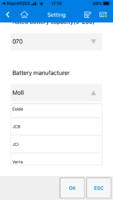I know it probably looks overkill to you but I was looking at the one below. On the subject of AGM also I keep reading about how many car manufacturers are going away from them.
L36-EFB Yuasa Leisure Battery 12V 100Ah
Are these codes in Taynas own Ebay?
L36-EFB Yuasa Leisure Battery 12V 100Ah
Are these codes in Taynas own Ebay?






